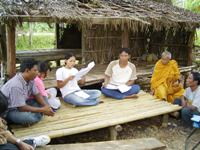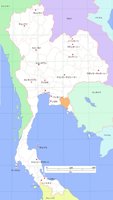|
Home >Locally-based projects >
Supporting Ethnic Minorities' Efforts to Conserve Bio-Cultural Diversities in Thailand
Biological and Cultural Diversities: Intertwined Whole
When we plot habitats of animals, plants, and other living organisms on a world map, we realize that much more species concentrate around the Equator. When we plot habitats of humans, we also find that many indigenous and ethnic minorities live in the same areas. In other words, places where biological and cultural richness exist seem to overlap. While biological diversities are being threatened in the globalizing world, cultural diversities are also at stake. Experts warn, for instance, that 20 to 50% of 7,000 languages currently in use on earth might lose their speakers and thus cease to exit before the end of the 21st century.
Some theories have been offered to explain why biological and cultural diversities exist side by side. Whichever explanations might be feasible, Mekong Watch believes it important to understand the two types of diversities closely linked to each other and thus to speak about bio-cultural diversities. It is also fair to assume that when minority groups can choose to protect their distinctive language, culture, and identity as a group, they can also continue to maintain more sustainable ways of living and using natural resources, which in turn can help preserve bio-cultural diversities. We would like to understand how these ideas might work in reality and help minorities decide their course of life for themselves. This is how we have come to participate in Chong people’s efforts to conserve bio-cultural diversities in eastern Thailand.
⇒Map on bio-cultural diversities (UNESCO)
|

Chong community leaders meet and
discuss the Chong Program
|

Chantaburi Province (in red)
|
Chong: the People, Culture, and Environment
Chong people these days live in western Cambodia and eastern Thailand. Their language, Chong, belongs to the Austro-Asiatic language family. Chong means people in the Chong language. Chong are traditional hunter-gathers and still rely on natural resources, such as those found in forests, for their life.
Chong people living on the Thai side concentrate in Chantaburi Province. The Chong population is estimated to be around 4,000. Virtually, all Chong people are native speakers of the Thai language, which belongs to a different language family. Very few Chong under 20 years of age can speak Chong at all. Due to increased contacts with the dominant Thai culture through Thai-style public education and mass media, Chong children hardly use Chong at home any more. Expanded urbanization, development projects, as well as export-oriented cash crop production accelerated under globalization are affecting their access to natural resources and environment.
Efforts to Conserve Bio-Cultural Diversities
Concerned that their language and culture might not be passed on to future generations, Chong communities decided to start the Chong Language and Culture Rehabilitation Program in 2000. They launched this program as part of their efforts to develop communities in more sustainable ways through preservation of local natural environment and resources.
As one of the first steps, Chong people worked with linguists at Mahidol University’s Institute of Languages and Cultures for Rural Development and developed a writing system for Chong, which had never been written. Villagers held a series of community workshops to discuss and test out Chong scripts to ensure that they could feel them as part of their culture. The established Chong writing system has enabled Chong people to document their cultural practices and traditions in their own language.
In 2000, nearly 2,000 Chong villagers participated in a community-initiated survey, in which 90% of respondents answered favorably about the Chong Rehabilitation Program. With consent from a local school, a class to teach the Chong language and culture to 3rd grade children started in 2002. This one-hour class, which has been expanded to 4th graders and to two other local schools since then, is taught three times a week for 20 consecutive weeks in 2 terms a year. The total amount of children’s exposure to the Chong language and culture amounts to 120 hours a year. Chong has become the first ethic minority language taught in a formal education system in Thailand.
On the biodiversity conservation end, Chong villagers have tried to preserve community forests and installed solar panels to generate electricity to run equipments to pump the water from a pond, symbolizing Chong people’s increased awareness over environmental conservation. They also visit forests in national parks to seek possibilities to start eco-tourism and environmental education not only for community members but also for outsiders who might be interested to visit their communities. Knowledge documented during these community-based research projects on plants, herbs, landscapes, and other natural resources are displayed at the Chong Community Learning Center, which was established in 2004.
|

Chong class at grade 3
|

Chong Community Learning Center
|
Outreaching Other Minorities
Chong communities have tried to share lessons learned from their efforts to conserve bio-cultural diversities with other ethnic minorities in Thailand. Nha Khur and Northern Khmer speakers in the northeast, as well as Malay-speaking villagers in the south have visited Chantaburi and exchanged their experiences and views as minorities with Chong villagers.
Outcomes and Challenges
Chong people have voiced favorable comments on the Chong Rehabilitation Program. Some have reported, “My children have started using Chong at home and I am so glad.” Others have said, “When I was a school child, we were banned to use Chong. We were not able to feel proud of being Chong. This has been completely changed now.” Yet others have pointed out, “Children’s abilities in reading Thai have also improved. This may be because they are studying the Chong scripts which have been developed from the Thai scripts.” While it is obvious that the Chong Rehabilitation Program has brought about changes to Chong communities, it should deserve a more comprehensive and systematic evaluation. It is also important to examine the Program’s impacts on and implications to biodiversity conservation.
Chong people’s experiences with bio-cultural diversity conservation have yet to be documented in more accessible manners and be shared with others. Their stories can be communicated to not only other minority groups who might be interested in starting similar programs but also to the general public. The general public can be educated about the significance of bio-cultural diversities as well as efforts to preserve them through Chong people’s experiences. Winning support from the general public can further motivate Chong villagers towards continuing and improving the Chong Rehabilitation Program.
|

Chong house
|
Links
Center for Endangered Languages and Cultures, Research Institute for Languages and Cultures of Asia, Mahidol University
http://www.lc.mahidol.ac.th/en/research-services-groups-endangered.php
Ethnologue
http://www.ethnologue.com/show_language.asp?code=cog
Foundation for Endangered Languages
http://www.ogmios.org/index.htm
TERRALINGUA
http://www.terralingua.org/
UNESCO Management of Social Transformation Linguistic Rights
http://www.unesco.org/most/ln2pol.htm
This project is funded by Nippon Koa’s Support Club Program and Yeon Environment Fund.
Last updated: October 29, 2010
|

